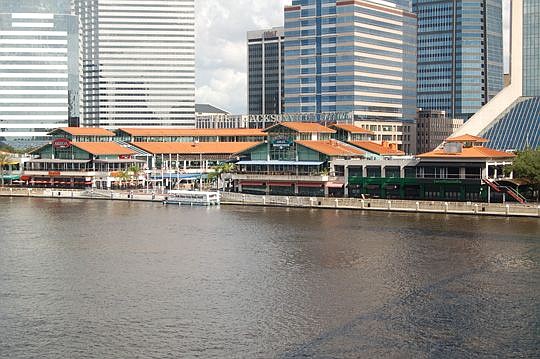
Redeveloping the Jacksonville Landing is “the most critical component of any plan to redevelop Downtown,” according to a draft study that could help shape the urban core’s project priorities.
Riverfront activation and adding to Downtown’s housing base over the next 20 years also rank high on the market feasibility study presented Wednesday to members of the Downtown Investment Authority.
Each comes with a price, though, and one likely dependent on taxpayer-funded incentives.
For instance, one of the keys for Landing retail development is securing a “national retailer as an anchor,” but such a store would need to be “heavily incentivized to enter the Landing — as high as $3 million for 20,000 square feet.”
On the housing side, there’s a goal of 10,000 new residents over the next 20 years, which would require 7,000 new units, or 350 per year. From 2000-13, though, a total of 1,500 units — or 115 per year — were added.
“These goals are considered achievable, but are not supported by past experience,” says the study from Red Rock Global LLC and Urbanomics Inc.
The city initiated the study to determine Downtown’s residential and commercial viability and needs moving forward, with the findings used to shape priorities within the authority’s plans.
Authority CEO Aundra Wallace said one of the takeaways from the market study is “clear” about the need for housing.
That housing component is another area where taxpayer incentives — another Wallace takeaway — could come into play. To attract those private investments, incentives could be used as they have been in the past — the study notes that such incentives provided to six projects since 2000 provided almost $60,000 per unit in subsidies for 1,200 units.
Landing housing can be a part of the early solution, as Sleiman Enterprises CEO Toney Sleiman has pitched the Downtown complex redevelopment as mixed-use. Early plans had up to a 20-story residential tower, but the study says it should be scaled down to five or six floors of residential above ground-floor commercial. It shouldn’t be more than 300 units, either.
The preference by Marriott Courtyard to possibly locate within the Laura Street Trio buildings also could make it “difficult” for the Landing to secure such a hotel — and development of one “will almost certainly require heavy public support and subsidy.”
But, passing on one would allow the possibility of “the highest residential rents possible in Downtown’s Northbank” because of other amenities, the report says.
Other projects like the Ambassador lofts could add 50 units and the Barnett Bank Building another 80.
Riverfront activation also is key in the feasibility plan through a “connect, captivate, celebrate” theme broken into three sections. “Connect” refers to Downtown west of the Fuller Warren Bridge, “captivate” with the Landing and “celebrate” in the Shipyards and Sports Complex area.
The latter ranks last on the priority list because of “world class design, developers and international capital” demands and has an attempted rebranding as the “Social Entertainment District” — or SEC District.
Overall, the authority started with $4.1 million this year in its economic development budget, but has resolved to spend about $1.5 million through a retail enhancement program and for a contract funding Hemming Plaza’s revitalization.
The market feasibility study will be finalized in the next several days.
Before the authority delved into the marketing study, it heard an update about the needs of public arts pilot program, should Downtown take the lead.
The urban art facade and streetscape program is geared toward recognizing local artist through their works on utility boxes, murals, bike racks and “graffiti” walls.
Most of the ideas are within the authority’s Community Redevelopment Area draft that it has worked on for some time, but ordinance changes will be needed to ensure legality — a local artist was arrested in recent weeks for painting on utility boxes and other urban facades.
As proposed, the pilot program would confine such artworks on public and private properties to a defined area.
“I love the idea of finding other ways to create demand in Downtown,” said board Chair Oliver Barakat, a real estate executive by profession.
The idea, he said, could add “distinction” for the core and would be a benefit.
@writerchapman
(904) 356-2466